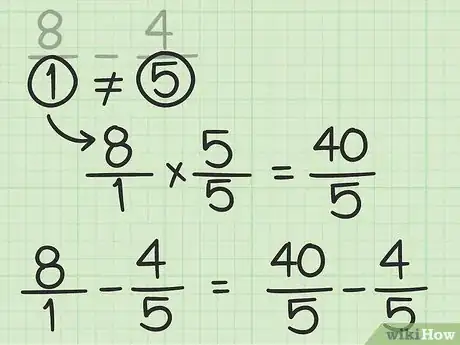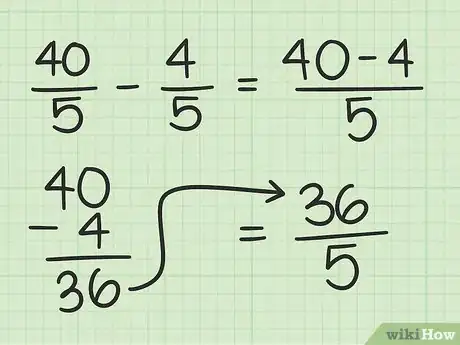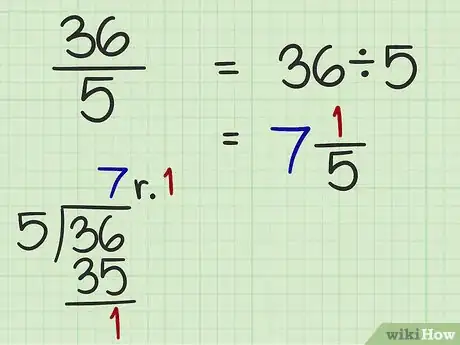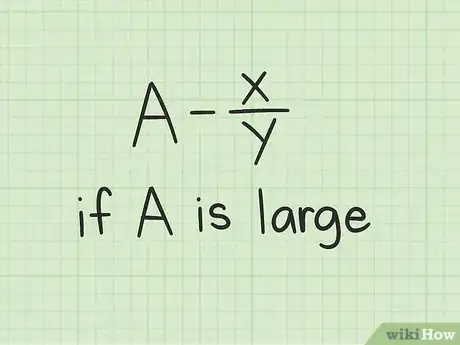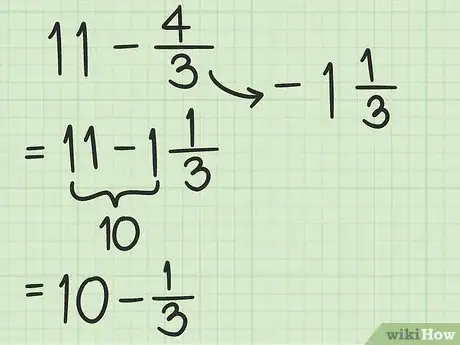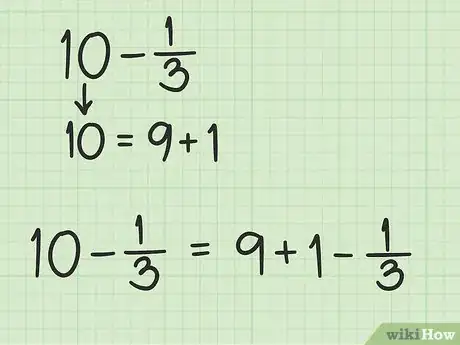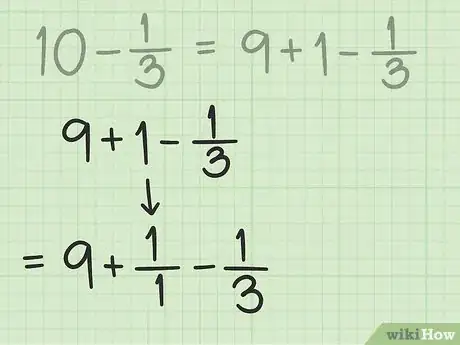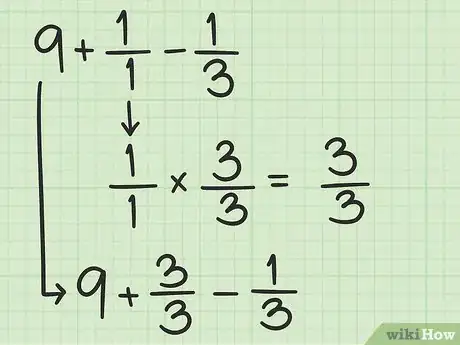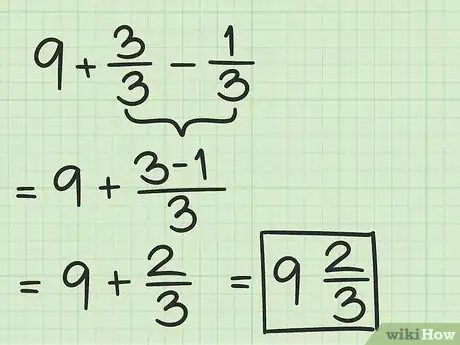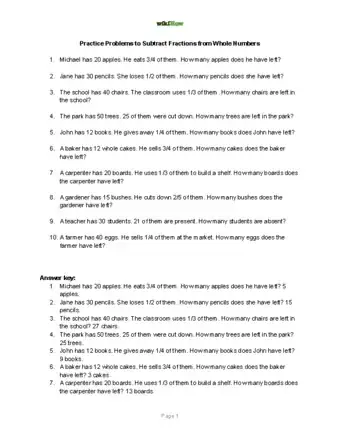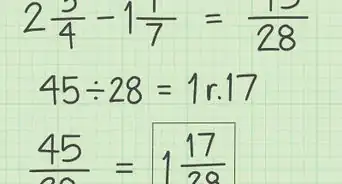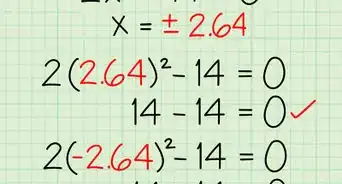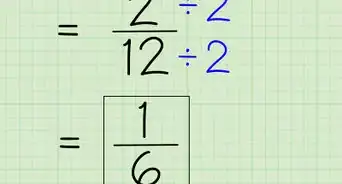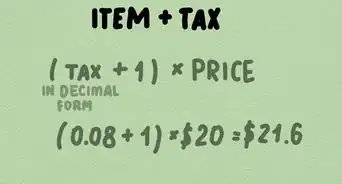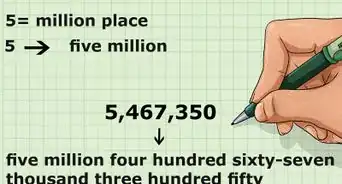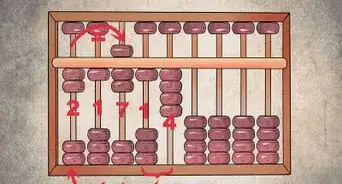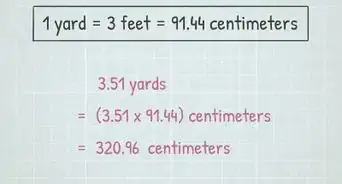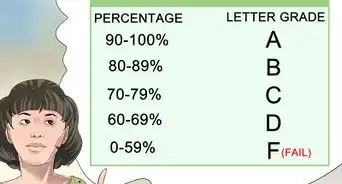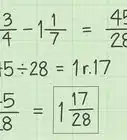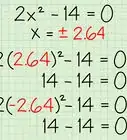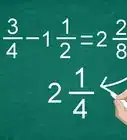This article was co-authored by David Jia. David Jia is an Academic Tutor and the Founder of LA Math Tutoring, a private tutoring company based in Los Angeles, California. With over 10 years of teaching experience, David works with students of all ages and grades in various subjects, as well as college admissions counseling and test preparation for the SAT, ACT, ISEE, and more. After attaining a perfect 800 math score and a 690 English score on the SAT, David was awarded the Dickinson Scholarship from the University of Miami, where he graduated with a Bachelor’s degree in Business Administration. Additionally, David has worked as an instructor for online videos for textbook companies such as Larson Texts, Big Ideas Learning, and Big Ideas Math.
This article has been viewed 961,863 times.
Subtracting fractions from whole numbers isn't as hard as it looks. There are two main ways to go about it: you can either convert the whole number into a fraction, or subtract 1 from that whole number and convert the 1 into a fraction with the same base as the fraction you're subtracting from it. Once you have two fractions with the same base, you can start to subtract. Both methods will help you.
Steps
Subtracting Fractions from Whole Numbers
-
1Convert the whole number to a fraction.To do this, give the whole number a denominator of 1.[1]
- Example:
-
2Convert to fractions of like denominators. The original fraction's denominator is also the least common denominator (LCD) of the two fractions. Multiply the top and bottom of the "whole number fraction" by this number so the fractions have the same denominator.[2]Advertisement
-
3Subtract the numerators. Now that the fractions have the same denominators, you can treat the numerators as a normal subtraction problem:[3]
- =
-
4Convert to a mixed number (optional). If your answer is an improper fraction, you may need to rewrite it as a mixed number:[4]
- Example: Rewrite as a mixed number.
- How many times does 5 fit evenly into 36? 5 x 7 = 35, so the whole number portion is 7.
- What's left over? The whole number portion is equivalent to , so solve - =
- Combine the whole number and fraction: =
Alternate Method
-
1Try this for large whole numbers. Did you see how the method above converts the whole number into a fraction, then converts back to a mixed number at the end? This method lets you skip some of that so the fraction only involves smaller numbers.
-
2Convert improper fractions to mixed numbers. Skip this step if your fraction is not improper. (An improper fraction has a larger number on top than on bottom.)[5]
- Example:
-
3Separate the whole number into 1 and another whole number. For example, rewrite 5 as 4 + 1, or rewrite 22 as 21 + 1.
-
4Convert the 1 into a fraction. At this point we're using the method above to solve the part of the problem in the form "1 - (fraction)". The other whole number will stay the same for the rest of the problem.
-
5Multiply to give the fractions like denominators. As described above, multiply the top and bottom of your new fraction so it has the same denominator as the original fraction.
-
6Combine the two fractions. Subtract the numerators to solve the fraction part of the equation.
Practice Problems and Answers
Community Q&A
-
QuestionIf the whole number is 1, then how am I supposed to make it into a fraction if 1/1 is 1 whole?
 DonaganTop AnswererAs a simple example, let's say we're subtracting ¾ from 1. Convert 1 to 4/4. 4/4 - ¾ = ¼. If the whole number is something else, let's say 6, and you're subtracting ¾, convert the 6 to 24/4. 24/4 - ¾ = 21/4, or 5¼.
DonaganTop AnswererAs a simple example, let's say we're subtracting ¾ from 1. Convert 1 to 4/4. 4/4 - ¾ = ¼. If the whole number is something else, let's say 6, and you're subtracting ¾, convert the 6 to 24/4. 24/4 - ¾ = 21/4, or 5¼. -
QuestionCan you help me with 5 5/6 - 2 2/3 step by step?
 WOOHPCommunity Answer1. 5 5/6 - 2 2/3 = 5 5/6 - 2 4/6 2. 5 5/6 - 2/4/6 = 3 1/6
WOOHPCommunity Answer1. 5 5/6 - 2 2/3 = 5 5/6 - 2 4/6 2. 5 5/6 - 2/4/6 = 3 1/6 -
QuestionI'm confused. Can you please give an example?
 Karianna WoodCommunity AnswerTake 3 - 2/7, for example. What over 7 is 3? 21, because 7 x 3 = 21. So 3 - 2/7 is the same as 21/7 - 2/7. What is 21/7 - 3/7? 21 - 3 = 18. So 21/7 - 3/7 = 18/7. (Optional) Simplify 18/7, which is 2 4/7. Does that help?
Karianna WoodCommunity AnswerTake 3 - 2/7, for example. What over 7 is 3? 21, because 7 x 3 = 21. So 3 - 2/7 is the same as 21/7 - 2/7. What is 21/7 - 3/7? 21 - 3 = 18. So 21/7 - 3/7 = 18/7. (Optional) Simplify 18/7, which is 2 4/7. Does that help?
Things You'll Need
- Pencil
- Paper
References
- ↑ http://virtualnerd.com/algebra-1/algebra-foundations/real-number-add-subtract/real-number-subtract/subtract-whole-number-from-fraction
- ↑ https://mathwizz.com/fractions/help/help11.htm
- ↑ https://www.youtube.com/watch?v=RVMktMqUvn8
- ↑ https://flexbooks.ck12.org/cbook/ck-12-middle-school-math-concepts-grade-6/section/5.15/primary/lesson/improper-fractions-as-mixed-numbers-msm6/
- ↑ https://www.mathsisfun.com/improper-fractions.html
About This Article
To subtract a fraction from a whole number, start by converting the whole number to a fraction. Do this by giving the whole number a denominator of 1. For instance, if you’re subtracting 4/5 from 8, convert 8 into the fraction 8/1. Next, multiply the new fraction’s numerator and denominator by the denominator of the fraction that you’re subtracting. In our example, you’d multiply 8/1 by 5 to get 40/5. Now you have two like fractions—that is, two fractions that share the same denominator. Carry out the subtraction problem using just the numerators of the two fractions. In this example, 40-4 = 36. Write the difference between the two numerators over the common denominator to get 36/5. If you want to convert the answer to a mixed fraction, divide the numerator by the denominator. The quotient will become the new whole number, while the remainder will become the numerator of the new fraction. In this case, 36/5 = 7 with a remainder of 1, giving you the mixed fraction 7 and 1/5. For a trick to help subtract a fraction from a very large whole number, read on!



